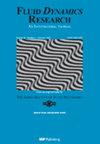严格基于Miller–Robert–Sommeria理论计算二维湍流统计平衡的新数值方法
IF 1.3
4区 工程技术
Q3 MECHANICS
引用次数: 0
摘要
在Miller–Robert–Sommeria(MRS)二维湍流统计力学理论的背景下,特别是在球面几何的情况下,提出了混合熵最大化问题的新的数值方法。其中两种方法是针对规范问题的;另一个是微正则问题。这些方法基于原始的MRS理论,因此考虑了所有的Casimir不变量。与以前研究中提出的方法相比,我们的新方法更容易检测多个统计平衡,并更容易搜索具有破坏纬向对称性的解。将这些方法应用于一个正压不稳定的带对称初始涡度分布。获得了两个统计平衡,其中一个具有纬向波数为1的波状结构,另一个具有带向波数为2的波状结构。前者是混合熵的最大点,而后者的波数2结构与涡度方程时间积分结束时出现的结构几乎相同。新方法允许有效计算由许多级别的涡度斑块组成的初始涡度分布的统计平衡,而不会丢失关于所有守恒量的信息。这意味着统计平衡可以从任意的初始涡度分布中获得,这允许应用统计力学来解释地球物理流体中出现的各种流动模式。本文章由计算机程序翻译,如有差异,请以英文原文为准。
New numerical methods for calculating statistical equilibria of two-dimensional turbulent flows, strictly based on the Miller–Robert–Sommeria theory
New numerical methods are proposed for the mixing entropy maximization problem in the context of Miller–Robert–Sommeria’s (MRS) statistical mechanics theory of two-dimensional turbulence, particularly in the case of spherical geometry. Two of the methods are for the canonical problem; the other is for the microcanonical problem. The methods are based on the original MRS theory and thus take into account all Casimir invariants. Compared to the methods proposed in previous studies, our new methods make it easier to detect multiple statistical equilibria and to search for solutions with broken zonal symmetry. The methods are applied to a zonally symmetric initial vorticity distribution which is barotropically unstable. Two statistical equilibria are obtained, one of which has a wave-like structure with zonal wavenumber 1, and the other has a wave-like structure with zonal wavenumber 2. While the former is the maximum point of the mixing entropy, the wavenumber 2 structure of the latter is nearly the same as the structure that appears in the end state of the time integration of the vorticity equation. The new methods allow for efficient computation of statistical equilibria for initial vorticity distributions consisting of many levels of vorticity patches without losing information about all the conserved quantities. This means that the statistical equilibria can be obtained from an arbitrary initial vorticity distribution, which allows for the application of statistical mechanics to interpret a wide variety of flow patterns appearing in geophysical fluids.
求助全文
通过发布文献求助,成功后即可免费获取论文全文。
去求助
来源期刊

Fluid Dynamics Research
物理-力学
CiteScore
2.90
自引率
6.70%
发文量
37
审稿时长
5 months
期刊介绍:
Fluid Dynamics Research publishes original and creative works in all fields of fluid dynamics. The scope includes theoretical, numerical and experimental studies that contribute to the fundamental understanding and/or application of fluid phenomena.
 求助内容:
求助内容: 应助结果提醒方式:
应助结果提醒方式:


